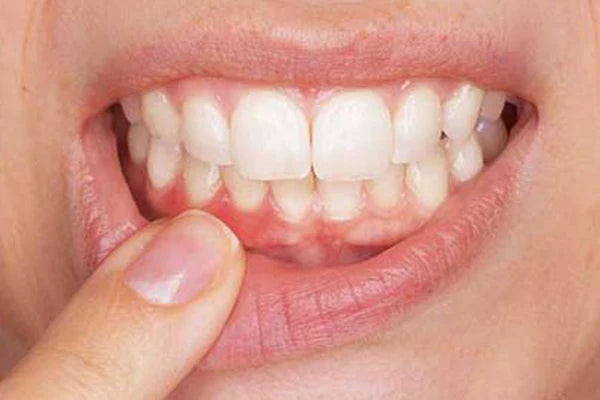The treatment of periodontitis aims at freeing the whole of the teeth and the gums from the inflammation and at preventing a new degradation. If periodontitis is discovered early, a basic treatment of the inflammation is often sufficient. However, if this does not work or if the periodontitis has progressed further, additional surgical interventions are necessary. In either case, patients with periodontal disease need ongoing follow-up by the dentist.
Here is a guide to help you understand in detail how periodontitis treatment works.
What is periodontitis?
Periodontitis or receding teeth is a bacterial infection that affects the bones, ligaments and tissues that surround and support your teeth. It is an advanced stage of gum problems because it is much more serious than simple gingivitis. Once it develops, it can lead to more serious problems such as tooth loss.
Accessories for good oral hygiene
Good oral hygiene is a prerequisite for successful treatment of periodontal disease. In a comprehensive consultation, the dentist or a specially trained professional should explain to the patient how to use a conventional or electric toothbrush, dental floss and interdental brushes. As a demonstration, plaque is often made visible with tooth staining tablets before the dentist removes them.
To maintain good oral hygiene, you can use the Y-Brush sonic electric toothbrush. It is a toothbrush that simplifies the brushing of all sides of the teeth simultaneously thanks to the filaments that have the right inclination which automates the gesture. The brushing is thus perfectly effective.
Treatments for periodontitis
Subgingival cleaning
Subgingival cleaning is also very important, i.e. the removal of bacterial plaque and tartar under the gums, on the dental necks and on the exposed dental roots. This is called "closed" periodontal treatment because the gums are not opened. The dentist cleans the gum pockets under local anesthesia, usually with fine instruments such as curettes or scalers, an ultrasound device or rotary instruments. Alternatively, subgingival instrumentation with a laser may be considered. The dentist also smoothes the accessible areas of the tooth roots to prevent bacteria from reattaching. The edges of crowns and protruding obscurations are also smoothed. As part of the basic periodontal treatment, the patient can also opt for a professional dental cleaning: the teeth are cleaned, polished and especially fluoridated.
Antibiotics for more severe forms
A basic treatment is often sufficient to stop the inflammation underlying the periodontal disease. In severe cases, however, additional antibiotic therapy may be necessary. Patients are usually prescribed antibiotic tablets for this. Sometimes antibiotics are also applied locally by applying them directly into a gum pocket in the form of a gel or ointment. In order to select an appropriate antibiotic, it may be helpful to first determine what bacteria are in the patient's gum pockets using laboratory tests.
Surgical procedures
Surgical periodontal treatment
It includes cleaning of deep gum pockets, regeneration of periodontal structures and plastic surgery to restore the gums, if necessary.
- It begins with the cleaning of the deep pockets of the gums. To do this, the dentist opens the pockets through a small incision under local anesthesia.
- This makes it easier to access areas that are infected with bacteria.
- Next, the dentist cleans the exposed root areas and removes the diseased tissue.
- Finally, he or she sutures the cut so that the gums are once again pressed against the tooth.
- With this procedure, the gums are supposed to adhere better and the gum pockets are eliminated.
Regeneration of the dental support system
- This is necessary when long-term or aggressive periodontitis has already destroyed so much connective tissue and bone that the teeth lose their anchorage.
- Be aware that bone tissue degraded by periodontitis can be partially rebuilt with a bone graft. Bone tissue from the body is usually used as an autologous bone graft.
- The dentist removes it from the back of the patient's jaw in a small operation and transplants it into the defective area (bone pocket).
- Alternatively, demineralized and freeze-dried bone tissue from another person can be transplanted: the dentist obtains such allogenic bone grafts from tissue banks.
The grafts can only improve the existing bone structure - complete regeneration has not yet been possible with them.
The dentist's follow-up
Since periodontitis is a chronic disease, good follow-up care must be provided over the long term, especially if the gums are already receding. Because then the necks and roots of the teeth are exposed and are therefore much more prone to cavities, because they are not protected by an enamel layer like the teeth.
The follow-up consists of :
- Consistent oral hygiene;
- Regular visits to the dentist;
- Regular professional cleaning of the teeth, possibly several times a year.
Often, dentists recommend a structured follow-up for their periodontitis patients called "periodontitis support treatment". It includes visits to the dentist every three months up to a maximum of 12 months depending on the degree of periodontitis. At these appointments, the dentist checks the success of the periodontal treatment so far, checks the oral hygiene and cleans the teeth. Controlling risk factors, including smoking and diabetes, is important for successful periodontal treatment. Periodontitis patients should refrain from smoking and control their diabetes with medical help.
We hope this guide has helped you understand what periodontitis is. We hope that before any treatment, you will use all the accessories to have a good oral hygiene. The treatments we have outlined are generally those offered by a dentist. Surgical interventions are generally the appropriate solution if the periodontitis worsens. In all cases, a follow-up by the dentist is necessary.



